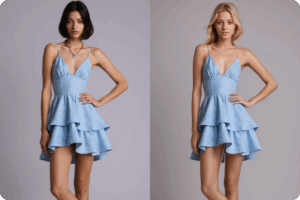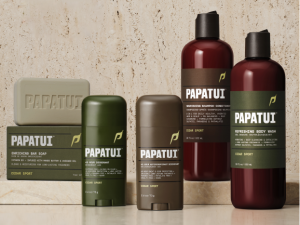The sustainable fashion movement has expanded in recent years, flourishing into an industry-wide trend. And it’s about time for the circular economy to gain traction since traditional clothing manufacturing is a pollutant. One previously underserved sector is the plus size. With a rise in body positivity, especially among millennials, those US Size 14/EU 44 and above expect plus fashion that fits well, looks smart, and is made of quality materials.

Sustainable Materials In Plus Size Fashion Innovations And Alternatives For A Greener Wardrobe
Plus Size Fashion And Plastics
According to Cotton Dayz, plus-size clothing necessitates a larger amount of fabric than smaller sizes. This greater material use inevitably leads to a larger environmental footprint, whether through water consumption, energy use, or the release of harmful toxins. As plus-size fashion grows its market share, addressing sustainability becomes more than a trend—it’s necessary. This is where sustainable fabrics make their mark, not only aiding in reducing the environmental impact but also offering benefits like durability, breathability, and health safety, specifically suited to the needs of plus-sized individuals.
Clothing manufacturers often use non-renewable resources, harsh chemicals, and unsustainable materials like polyester to make their products. In fact, a staggering 60% of all clothing materials are actually derived from plastic or, to be more specific, synthetics such as nylon, acrylic, and polyester. An overlooked consequence of washing synthetic garments is the release of tiny plastic microfibers into our water supply. Textile and fashion waste (including plus-size fashion) is accountable for 9% of microplastic pollution in our oceans. Furthermore, the combined impact of the footwear and garment industries accounts for 8% of global greenhouse gas emissions, highlighting their substantial contribution to environmental issues.
Innovations And Alternatives In Sustainable Fabrics
In pursuing greener alternatives, the fashion industry has explored various materials. These aren’t just better for the environment but also offer specific advantages for plus-size fashion:
- Organic Cotton
While traditional cotton farming relies heavily on water and pesticides, organic cotton is grown using methods with less environmental impact. It’s soft, breathable, and durable, making it an excellent choice for plus-sized clothes.
- Hemp
This fast-growing plant produces a remarkably strong and durable fabric, excellent for clothing that needs to withstand more strain. It’s also naturally resistant to mold and UV light, adding to its longevity.
- Bamboo
Bamboo fabric is silky, breathable, and has excellent moisture-wicking properties. It’s ideal for plus-size activewear and undergarments.
- Pineapple
Piña is a traditional Philippine fabric made from pineapple plant leaves. The fibers are painstakingly extracted by hand and then knotted together and woven on a loom. The result is a beautifully translucent, delicately patterned material like a cross between organza and silk used mainly for formal wear. While piña is made traditionally, Piñatex, an innovation of Dr Carmen Hijosa from discarded pineapple leaves, is a stiffer material that can simulate leather after processing.
- Apple
Like pineapple, apples have been turned into leather. Apple leather is an innovative, sustainable material gaining traction in the fashion industry. As the name suggests, it’s made from apples, specifically the waste generated during apple juice production. This waste includes apple skins and cores, which would otherwise be thrown away. The final product is a material that’s not only sustainable but also has many of the qualities that make traditional leather so popular. Apple leather is durable, breathable, and UV-resistant, making it ideal for items like shoes and wallets. Apple leather represents a significant step forward in sustainable fashion, providing a high-quality, vegan alternative to traditional leather that helps reduce waste and promote more sustainable manufacturing practices.
- Natural Source Of Dyes
Natural dyes have been used for centuries and are gaining popularity as the fashion industry seeks to become more sustainable. However, it’s important to note that using natural dyes requires careful management to ensure the process remains sustainable and doesn’t negatively impact local ecosystems.A potential modern approach includes using pigment-producing microorganisms, which could meet the demand for natural dyes while minimizing the impact on ecosystems. This method is still under development but represents a promising future direction for sustainable textile dyes.
- Recycled Materials
Fabrics made from recycled plastic bottles or discarded fishing nets are rising in popularity. While they might not have the natural origin of the others, they’re helping to reduce the volume of waste in our oceans or landfills.

Sustainable Materials In Plus Size Fashion Innovations And Alternatives For A Greener Wardrobe
Conclusion
Plus-size fashion is an aspect ripe for innovation so that waste, by-products, and toxic degradation from synthetic materials can be reduced. This fashion in garments and footwear uses more material, consumes more ink, creates more production waste, degrades longer, and fills more volume in landfills. Natural fibers and dyes can be used sustainably for greener wardrobes and footwear. This shift to greener alternatives isn’t just about being ecologically responsible. It’s about addressing some unique issues that plus-size customers face, from durability to comfort while significantly reducing their environmental footprint.

fashionabc is a fashion technology platform, comprising a digital directory and various other digital tools and supply chain solutions for the fashion industry ecosystem, that focus on ethical fashion and sustainability. We are building inclusive digital transformation tools for fashion professionals who are willing to take steps towards a more sustainable ethical fashion industry, by adopting AI and DLT blockchain technology.
* building digital profile and IP solutions for fashion businesses
* tackle issues such as provenance and counterfeit in supply chain
* contribute to the construction of a meritocratic ethical fashion industry which is certified and part of the circular economy










